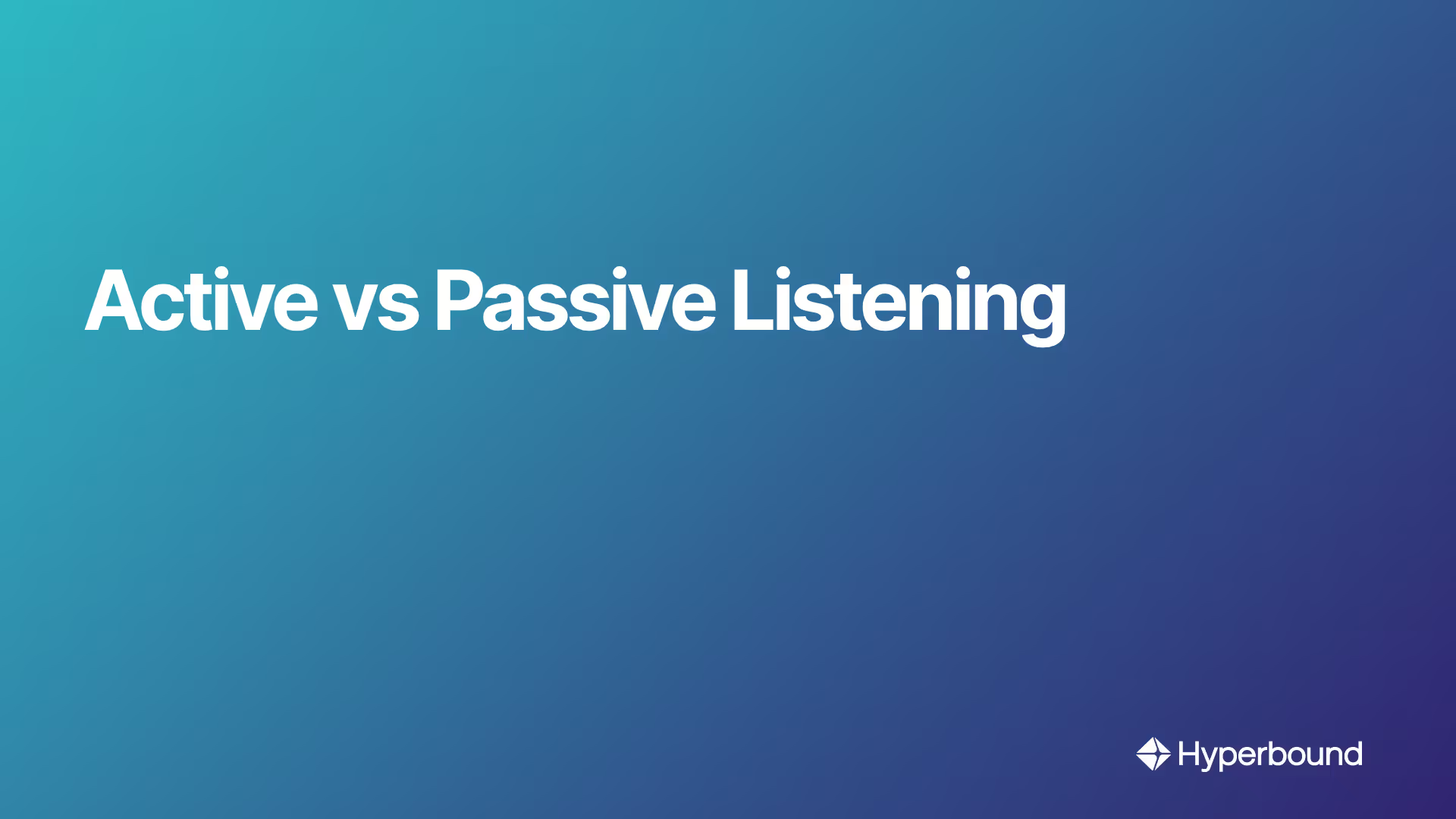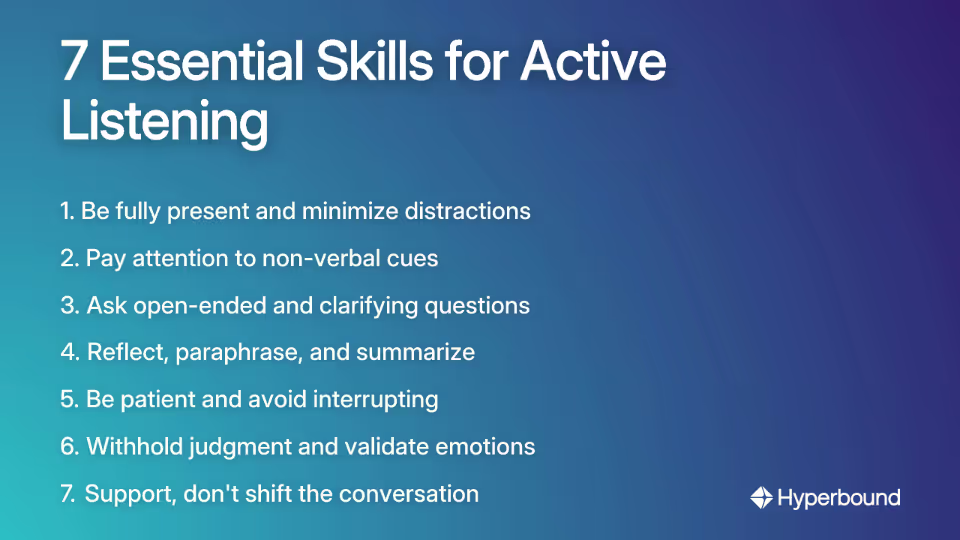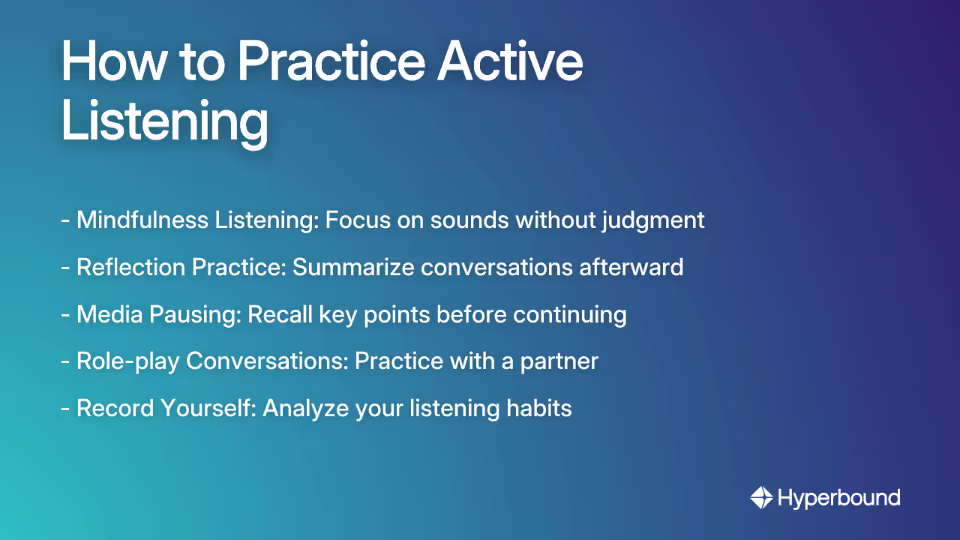
Have you ever found yourself nodding along in a conversation while your mind wanders elsewhere? Or maybe you've responded with "yeah, right, true" only to realize you completely missed the most important part of what someone was saying? If so, you're not alone in struggling with the difference between simply hearing words and truly listening.
Many of us fall into the habit of waiting for our turn to speak rather than genuinely absorbing what others share. As one person confessed in an online discussion, "Sometimes I feel like I'm just waiting for my turn to talk instead of really listening."
The distinction between passive and active listening represents the difference between merely receiving information and genuinely connecting with another person. Understanding this difference can transform your relationships, boost your career, and fundamentally change how you experience conversations.
Decoding Listening: The Difference Between Hearing and Understanding
Passive Listening: The "Autopilot" Mode
Passive listening is exactly what it sounds like—receiving information without providing meaningful feedback or showing full engagement. While listening is passive by nature in terms of receiving rather than producing sound, true passive listening goes further: your ears function, but your mind may be elsewhere.
In this mode, you might hear the words someone is saying, but you're not processing them deeply or responding in ways that demonstrate understanding. You're essentially on autopilot, perhaps planning your grocery list, thinking about work, or formulating your response while the other person is still speaking.
Passive listening does have its place:
- During casual conversations where deep attention isn't required
- When absorbing background information that doesn't directly pertain to you
- In certain learning environments like lectures or when listening to music or podcasts
The problem arises when passive listening becomes your default mode in important conversations. As one Reddit user admitted, "I feel like I'm always listening and engaged with what she's saying, but turns out I miss the most important thing she said quite often and slip into a mode of just going 'yeah! Right? True! Aww' without really realizing it."
Active Listening: The "Fully Engaged" Mode
Active listening, by contrast, is the practice of listening with the genuine intent to understand rather than simply respond. It's a conscious choice to be fully present with another person, focusing exclusively on what they're communicating without planning your reply or judgment.
According to Harvard Business Review, active listening involves three core components:
- Avoiding distractions: Intentionally eliminating external interruptions and internal distractions
- Using non-verbal cues: Employing gestures like nodding and appropriate eye contact to signal engagement
- Reflective listening: Summarizing or paraphrasing what you've heard to verify understanding
Active listening isn't just being quiet while another person speaks—it's a dynamic process that requires energy and attention. It's about creating a space where the speaker feels truly heard, understood, and validated.
'The Seven Essential Skills of an Active Listener
Becoming an effective active listener requires developing specific skills that demonstrate your engagement and facilitate genuine understanding.

1. Be Fully Present and Minimize Distractions
The foundation of active listening is giving your complete attention to the conversation:
- Put away your phone and turn off notifications
- Find a quiet environment when possible
- Practice mindfulness if your mind wanders—gently bring your focus back to the speaker
- Remember that listening is passive in receiving sound, but active in how you process it
As one person shared on Reddit, "Be fully present: show the person your engagement, avoid distractions, and focus on what the other one is saying."
2. Pay Attention to Non-Verbal Cues
Up to 65% of communication is nonverbal, according to research cited by VeryWell Mind. This makes observing body language critical:
Your cues:
- Maintain comfortable eye contact (about 50-70% of the time)
- Nod occasionally to show understanding
- Lean slightly forward to demonstrate interest
- Keep an open posture (uncrossed arms)
Their cues:
- Watch for facial expressions that might contradict words
- Notice changes in tone, volume, or pace of speech
- Observe gestures and posture that reveal emotional states
3. Ask Open-Ended and Clarifying Questions
Questions that require more than a simple yes/no response encourage deeper conversation:
- Instead of "Did that upset you?" try "How did that situation affect you?"
- Use prompts like "Can you tell me more about that?" or "What do you think led to that outcome?"
As one user recommended, "Ask open-ended questions: it will encourage the person to share more about their thoughts and feelings and make a conversation deeper."
4. Reflect, Paraphrase, and Summarize
This crucial skill demonstrates that you're not just hearing words but processing meaning:
- Paraphrase key points: "So what you're saying is..."
- Reflect emotions: "It sounds like you felt frustrated when that happened."
- Summarize periodically: "Let me make sure I understand—you're concerned about X, Y, and Z."
This technique serves as a reality check for both parties, ensuring you've understood correctly and giving the speaker a chance to clarify if needed.
5. Be Patient and Avoid Interrupting
Many of us struggle with the urge to jump in with our thoughts before others finish speaking:
- Allow complete silence after someone finishes speaking before responding
- If you feel the urge to interrupt, take a breath and refocus on listening
- Remember that interrupting sends the message that your thoughts are more important than theirs
One Reddit user noted the importance of "Don't interrupt: allow them to finish their thoughts before responding."
6. Withhold Judgment and Validate Emotions
Creating a safe space for communication means suspending evaluation:
- Focus on understanding their perspective rather than determining if they're "right"
- Acknowledge emotions even when you don't share their viewpoint
- Use phrases like "I can understand why you'd feel that way" or "That makes sense given your experience"
7. Support, Don't Shift the Conversation
A common mistake is redirecting conversation back to our own experiences:
- Resist the urge to say "That reminds me of when I..."
- Keep follow-up questions focused on their story
- If sharing your experience would be helpful, ask permission first: "Would it help if I shared a similar experience I had?"
The Real-World Payoff: Why Active Listening Matters
The benefits of active listening extend far beyond just having more pleasant conversations. They can transform your professional success and personal relationships.

In Your Professional Life
Builds Trust & CollaborationWhen colleagues feel truly heard, they're more likely to trust your judgment and work effectively with you. This is particularly important for leaders—team members who feel listened to report higher job satisfaction and engagement.
Reduces Errors & MisunderstandingsAs one professional admitted on Reddit, "I never thought my active listening skills were this bad... I've noticed I'll oftentimes have to ask my colleagues the same question over and over again, which of course frustrates them." Active listening helps you get it right the first time, reducing the need for clarification and preventing costly mistakes.
Crucial for Key MomentsActive listening becomes indispensable during job interviews, negotiations, client meetings, and conflict resolution. These high-stakes situations require complete understanding of nuances, concerns, and underlying needs.
In Your Personal Life
Strengthens RelationshipsPerhaps nowhere is active listening more valuable than in intimate relationships. One Reddit user made a powerful observation: "I realize my wife being heard directly correlates to her libido." When partners feel genuinely understood, it creates emotional intimacy that strengthens all aspects of the relationship.
Reduces Loneliness & Fosters BelongingBeing truly heard is a fundamental human need. When you provide this for others, you help combat the epidemic of loneliness while creating deeper connections.
Enhances Problem-SolvingMany relationship conflicts stem from misunderstandings rather than actual disagreements. Active listening allows you to identify the real issues at hand and work together toward solutions.
Overcoming the Barriers: Why Is Listening So Hard?
Despite its importance, active listening doesn't always come naturally. Several barriers can make it challenging:
Internal Barriers
- Internal Dialogue: The constant stream of thoughts in your own mind
- Stress and Distraction: When you're preoccupied with personal concerns
- Assumptions: Believing you already know what someone will say
- Lack of Interest: Struggling to engage with topics that don't naturally interest you
External Barriers
- Environmental Noise: Physical distractions in your surroundings
- Digital Interruptions: Notifications and devices competing for attention
- Time Pressure: Feeling rushed or impatient
The Neurodivergent Perspective
It's important to acknowledge that traditional active listening advice can sometimes feel restrictive, particularly for neurodivergent individuals. As one person shared on Reddit, "This is a social dance that may or may not have any actual benefit, and it exhausts me as a lot of the time in order to 'active listen' I have to do a lot of masking."
True active listening should focus on understanding, not performance. If fidgeting helps you concentrate, or if occasional eye contact works better than sustained gaze, that's perfectly valid. The goal is comprehension and connection, not conforming to rigid social rules.
From Theory to Practice: Building Your Listening Muscle
Like any skill, active listening improves with deliberate practice:

Try These Exercises
- Mindfulness Listening: Spend 5 minutes focusing solely on the sounds around you without judgment. This helps train your brain to stay in the present moment.
- Reflection Practice: After a conversation, write down the main points discussed without checking notes. This strengthens your recall and comprehension.
- Media Pausing: While watching shows or listening to podcasts, pause periodically to summarize what you've heard. This turns passive consumption into an active exercise.
- Role-play Conversations: Practicing with a partner is a great way to get feedback. For professional teams needing to scale this, platforms like Hyperbound offer AI-powered roleplays that simulate realistic customer conversations, allowing reps to hone their listening skills in a safe, repeatable environment.
- Record Yourself: Analyzing your own conversations can reveal habits like interrupting or conversational tics. To take this a step further, tools like Hyperbound's AI Real Call Scoring can automatically analyze your conversations against a proven methodology, providing objective insights that are difficult to spot on your own.
Example in Action
Passive Response:Friend: "I'm really stressed about this project deadline."You: "Yeah, deadlines are tough. I had a crazy one last month."
Active Response:Friend: "I'm really stressed about this project deadline."You: "It sounds like you're feeling overwhelmed. What about the deadline is causing the most pressure?" (validates emotion, asks an open-ended question)
The Power of Choosing to Understand
The difference between passive and active listening ultimately comes down to choice—the choice to move beyond simply hearing sounds to truly engaging with another human being.
Remember that active listening is not about perfectly following rules or techniques. It's about being present, curious, and empathetic. With practice and patience, you can transform your conversations, deepen your connections, and build more meaningful relationships in every area of your life.
By mastering the distinction between passive listening (where listening is passive by nature) and active listening (where you deliberately engage), you'll discover the profound impact that truly hearing others can have—not just on them, but on your own experience of the world.

Frequently Asked Questions
What is the main difference between active and passive listening?
The main difference is engagement: active listening involves consciously processing and responding to information, while passive listening is merely hearing sounds without full comprehension. Passive listening is like being on "autopilot"—your ears pick up words, but your mind is elsewhere. Active listening, in contrast, requires your full presence. It means focusing on understanding the speaker's message, using non-verbal cues to show engagement, and reflecting on what was said to confirm you understood correctly.
Why is active listening important in the workplace?
Active listening is crucial in the workplace because it builds trust, reduces costly misunderstandings, and improves collaboration among team members. When employees and leaders practice active listening, they create a more engaged and psychologically safe environment. This leads to higher job satisfaction, fewer errors from miscommunication, and more effective outcomes in critical situations like negotiations, client meetings, and conflict resolution.
How can I practice active listening?
You can practice active listening by making a conscious effort to minimize distractions, ask open-ended questions, and paraphrase what you hear to ensure you understand. Start with simple exercises like mindfulness listening, where you focus only on sounds around you. During conversations, put your phone away, maintain eye contact, and resist the urge to interrupt. Periodically summarize the speaker's points by saying, "So, what I'm hearing is..." to confirm your understanding and show you are engaged.
What are the signs of passive listening?
Common signs of passive listening include frequently missing important details in conversations, nodding along without processing the information, and thinking about your response while the other person is still speaking. If you often find yourself saying generic replies like "yeah" or "right" without being able to recall what was just said, you are likely in a passive listening mode. Other signs include being easily distracted by your phone or internal thoughts and a tendency to interrupt or shift the conversation back to yourself.
What are some common barriers to active listening?
The most common barriers to active listening are internal distractions like your own thoughts and external factors like environmental noise or digital interruptions. Internally, things like stress, lack of interest in the topic, or making assumptions about what the speaker will say can prevent you from truly listening. Externally, a noisy room or constant notifications from your phone can pull your attention away. Overcoming these requires a conscious effort to be present and focused.
Can you be a good active listener if you are neurodivergent?
Yes, neurodivergent individuals can be excellent active listeners by focusing on genuine understanding rather than conforming to rigid social norms like constant eye contact. The goal of active listening is connection and comprehension, not performing a specific set of actions. If fidgeting helps you concentrate or you prefer less direct eye contact, those methods are perfectly valid. True listening is about what works best for you to process information and show the speaker you are engaged in a way that is authentic to you.
Book a demo with Hyperbound
.png)













